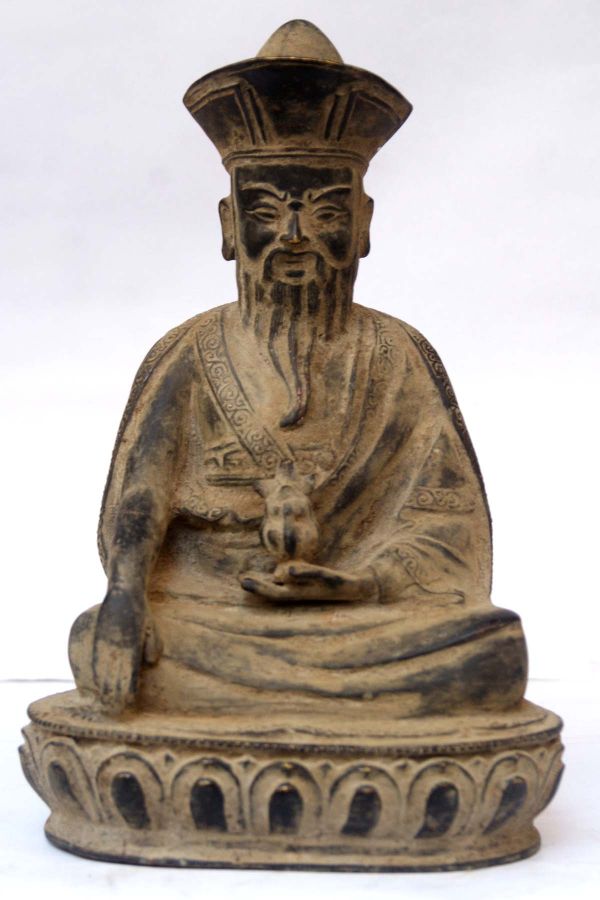High Lamas can manifest in different forms, such as the Mind emanation, Body emanation or Speech emanation. Jigme Norbu was a layman who was recognised as the Mind emanation of Zhabdrung Ngawang Namgyal (1594-1651). To understand the importance of this incarnation, we must look at the achievements of Zhabdrung Ngawang Namgyal, who was the reincarnation of one of the main lineage holders of the Drukpa Kagyu tradition, Padma Karpo (1527-1592).
History
Zhabdrung Ngawang Namgyal was key in reinstating the independence of Bhutan from Tibet under the reign of H.H. the 5th Dalai Lama and seen as the founder of Bhutan. Zhabdrung Ngawang Namgyal also established two systems of administrative power in Bhutan; one led by the Desi, who was responsible for civil administration while the other, led by Je Khenpo, was responsible for the spiritual administration of the country as the central monk body.
As a result of the enormous infighting among the succession of Desis, its role became redundant when the Bhutanese Monarchy came into power in 1907. However, the role of the Je Khenpo remains, and he is seen as the head of the Drukpa Kagyu school of Buddhism in Bhutan.
After the passing away of Zhabdrung Ngawang Namgyal, three incarnations were identified, one for his body, one for his speech and one for his mind. However, only the mind reincarnation was recognized to be his successor, and called the Zhabdrung.
Jigme Norbu, the Fourth Mind Incarnation of the Zhabdrung, was born into the respected family line of the renowned Bhutanese Nyingma terton, Pemalingpa (1450-1521), whose Nyingma teachings had became part of the Drukpa lineage. His list of teachers included several important Je Khenpos, including Sherab Gyaltsen (25th Je Khenpo), Padma Zangpo (27th/29th Je Khenpo), Jampel Gyatso (30th Je Khenpo), and Yonten Gyaltsen (31st Je Khenpo).
After Jigme Norbu was recognized as the mind reincarnation of the Zhabdrung, he was enthroned as the Desi in 1851 under the recommendation of the Central Monk Body. However, Jigme Norbu did not want to be ordained and decided to take a consort to practice advanced Mahamudra.
He also had a daughter. This was not well looked upon by Bhutanese society. That, combined with a suspicion that he was involved in a political coup, were the reasons behind his resignation in 1852. Soon after, he left his monastic seat, Talo Sanga Choling, which is located at Talo valley, and journeyed to Tibet.
Later, Jigme Norbu returned to Gorina, the monastery which was founded by his teacher, Sherab Gyeltsen, and passed into clear light at the age of 31.
Jigme Norbu's compositions were published as one volume (1071 pages) by the National Library of Bhutan in 1984. It is entitled, "The Collected Works of the Fourth Zhabdrung Tulku of Bhutan, Jigme Norbu (1831-1861)". Among the many great writings by Jigme Norbu is a ritual to various protectors. The introduction emphasized Guru Rinpoche Padma Thotrend as "Powerful Lotus of the Garland of Skulls". He is regarded as a valid object of refuge for us and all of his followers, particularly the terton Pemalingpa and their protectors.
The ritual explains how to set up tormas, and explanations on different sections, such as the invocation and prostration. Protectors mentioned in this ritual include Mahakala, Tsering Chenga, Shinkongma, Rahula, Pam Busum, Tsiu Marpo, Palden Lhamo, Chatri Tsengod, Dorje Shugden, and Jagpa Melen.
There are many similarities in Jigme Norbu's writings to the 17th century Drukpa master, Drubwang Dreuley. Dreuley is the only other recorded Drukpa Master in Bhutan to have propitiated Dorje Shugden. Within the text authored by Jigme Norbu, as in the ritual by Dreuley, Dorje Shugden is specifically invoked from Lanka and Lhasa and at the end of the ritual, there is a praise to all protectors.
The volume also included a ritual specifically devoted to Dorje Shugden which seems to have drawn from the ritual written by the previous Drukpa master Dreuley. For example, the verses at the beginning that describe Dorje Shugden match those in the ritual composed by Dreuley.
Throughout the ritual, there are verses that seem to match verbatim, verses that match but with slight amendments, as well as completely new verses. The amendments included the many places where Dorje Shugden resides, such as Sakya Monastery, Doldum Bu Chokor, and Trode Khangsar in Lhasa. These places are all mentioned in the verses just before the invocation prayers. In Dreuley's ritual, we find the same invocation praises, with only marginal variations.
We find identical verses of praise in both rituals. However, in Jigme Norbu's first line of praise, which was modified from Dreuley's ritual, Dorje Shugden is asserted to be the great protector who is the collection of all Buddha's power, thus referencing Shugden's own indisputably enlightened nature. There are also references and praises across the text to Guru Rinpoche, a rare connection that is not commonly associated with Dorje Shugden practice. For example, in the confession verses, it reads:
Ordered to protect the essential doctrine
By Padma Wang and Jamyang father and sons
Heruka and Vajrakapalamalin [Guru Rinpoche],
Dorje Shugden and retinue consider me.
While later verses in the enthronement parts of the ritual read:
Fully empowered and vajra-sealed
By deathless Vidyadhara Vajrakapalamalin [Garland of Skulls Guru Rinpoche],
To protect the general and specific doctrine,
I enthrone you as the Great King of Dharma Protectors.
We must take note especially of the clear references made within Jigme Norbu's writings of Dorje Shugden's Buddha nature and his intricate connection to Guru Rinpoche. In view of the uniqueness of this ritual, which has praises to Guru Rinpoche throughout, we could wonder if Dorje Shugden is a very special protector to this Great Master alone in Bhutan, or to all its previous great masters as well
